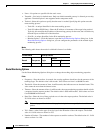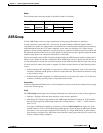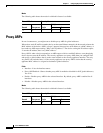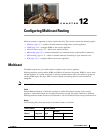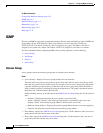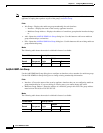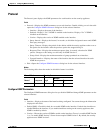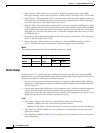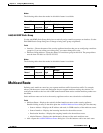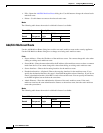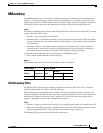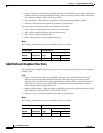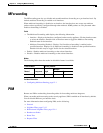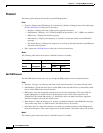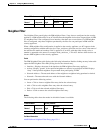
12-6
Cisco ASDM User Guide
OL-16647-01
Chapter 12 Configuring Multicast Routing
IGMP
• Query Interval—Enter the interval, in seconds, at which the designated router sends IGMP
host-query messages. Valid values range from 1 to 3600 seconds. The default value is 125 seconds.
• Query Timeout—Enter the period of time, in seconds, before which the security appliance takes over
as the querier for the interface after the previous querier has stopped doing so. Valid values range
from 60 to 300 seconds. The default value is 255 seconds.
• Response Time—Enter the maximum response time, in seconds, advertised in IGMP queries. If the
security appliance does not receive any host reports within the designated response time, the IGMP
group is pruned. Decreasing this value lets the security appliance prune groups faster. Valid values
range from 1 to 12 seconds. The default value is 10 seconds. Changing this value is only valid only
for IGMP Version 2.
• Group Limit—Enter the maximum number of host that can join on an interface. Valid values range
from 1 to 500. The default value is 500.
• Forward Interface—Choose the name of an interface to forward IGMP host reports to. Choose
“None” to disable host report forwarding. By default, host reports are not forwarded.
Modes
The following table shows the modes in which this feature is available:
Static Group
Sometimes, hosts on a network may have a configuration that prevents them from answering IGMP
queries. However, you still want multicast traffic to be forwarded to that network segment. There are two
methods to pull multicast traffic down to a network segment:
• Use the Join Group pane to configure the interface as a member of the multicast group. With this
method, the security appliance accepts the multicast packets in addition to forwarding them to the
specified interface.
• Use the Static Group pane configure the security appliance to be a statically connected member of
a group. With this method, the security appliance does not accept the packets itself, but only
forwards them. Therefore, this method allows fast switching. The outgoing interface appears in the
IGMP cache, but itself is not a member of the multicast group.
Fields
• Static Group—Displays the statically assigned multicast groups for each interface.
–
Interface—Displays the name of the security appliance interface.
–
Multicast Group Address—Displays the address of a multicast group assigned to the interface.
• Add—Opens the Add/Edit IGMP Static Group dialog box. Use this button to assign a new static
group to an interface.
• Edit—Opens the Add/Edit IGMP Static Group dialog box. Use this button to edit an existing static
group membership.
Firewall Mode Security Context
Routed Transparent Single
Multiple
Context System
• — • ——



